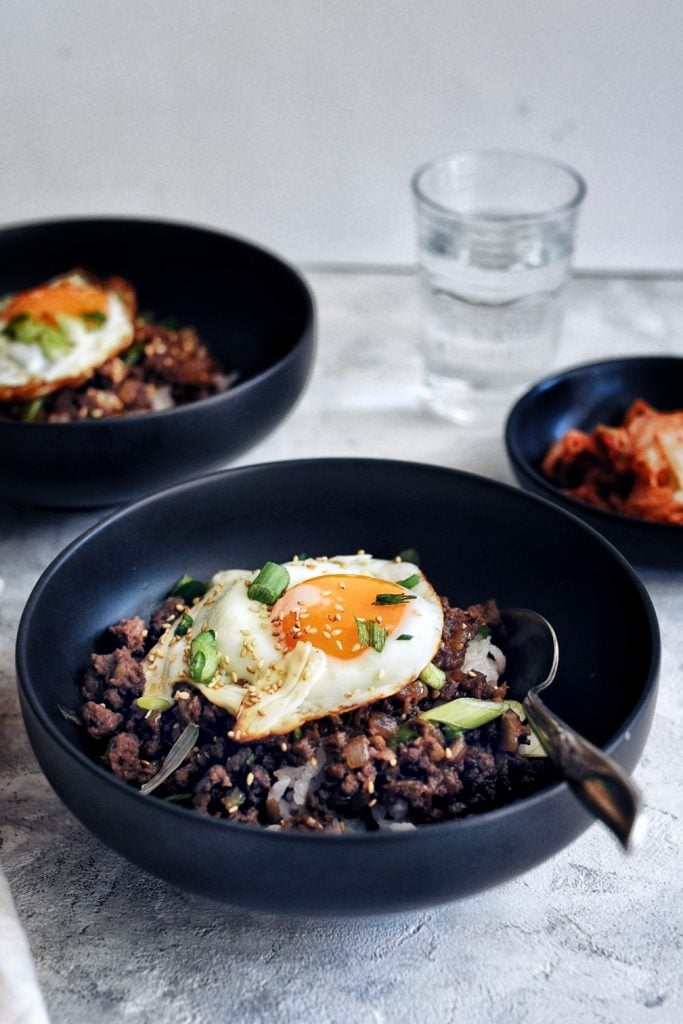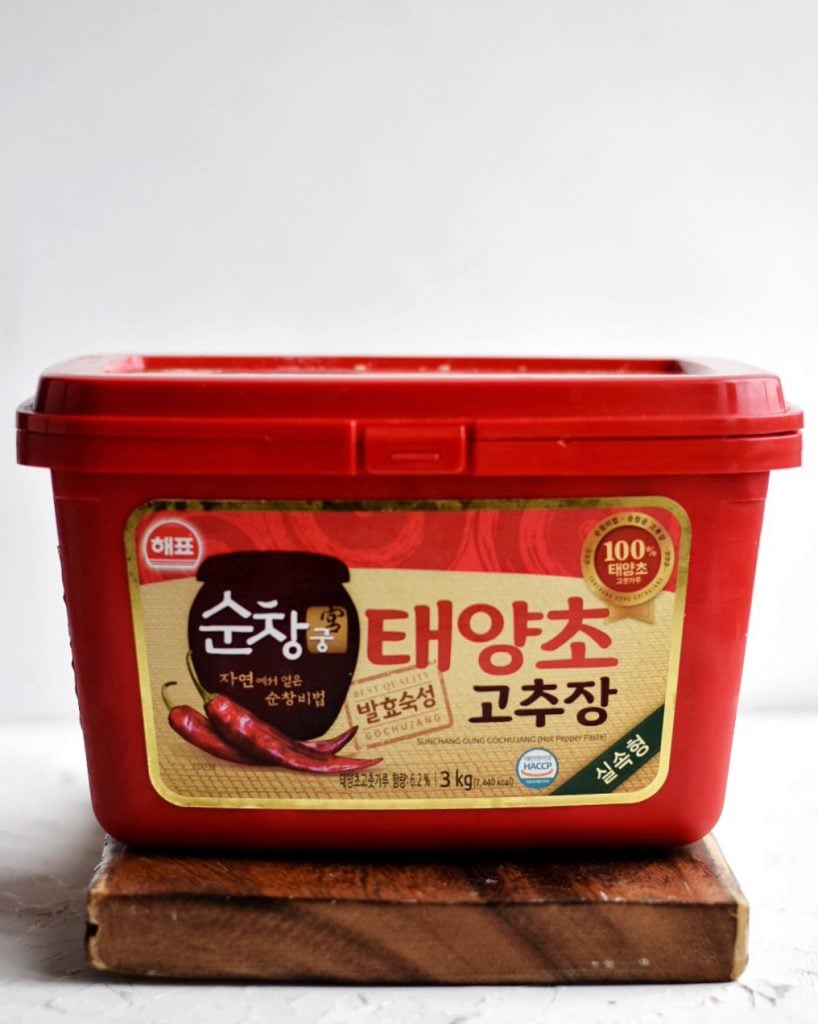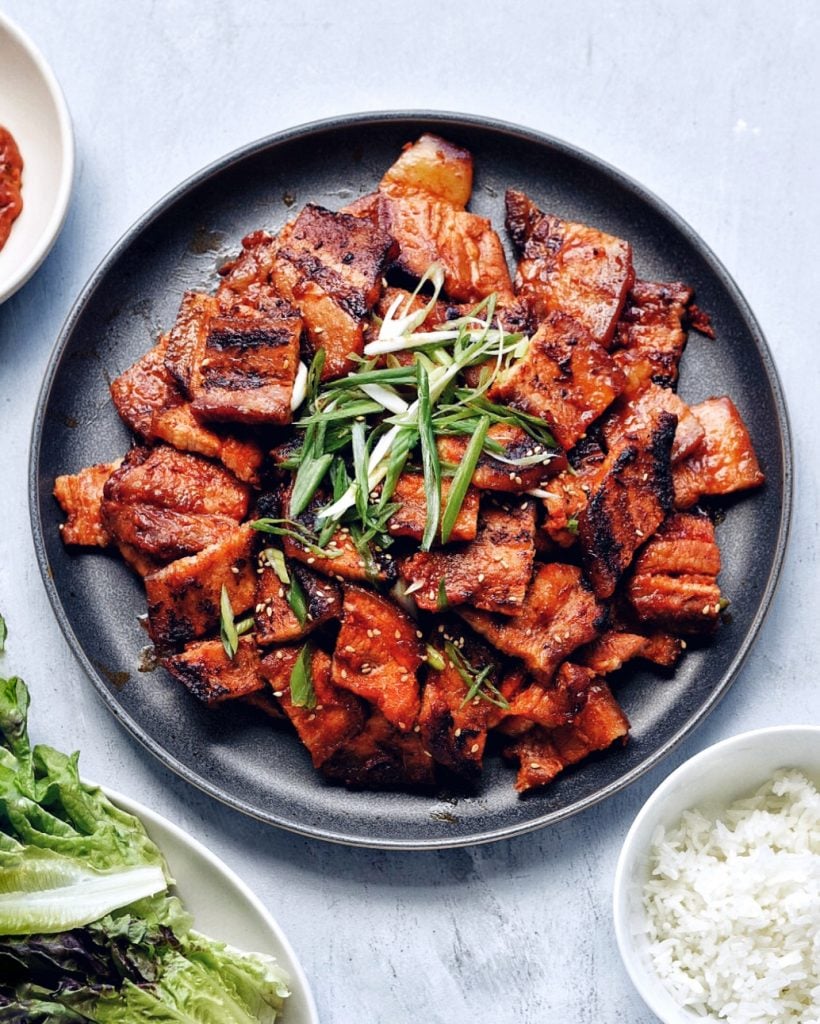Make Korean Spicy Pork Belly Bulgogi at home — an indulgent, delicious, and easy-to-make dish! A spicy-sweet Gochujang marinade and thinly sliced pork belly strips are cooked until sizzling hot. A flavorful recipe made with simple ingredients. Enjoy this Korean barbecue classic with rice, lettuce wraps, and kimchi.
There are so many reasons to love Korean Pork Belly. Thin slices of fatty pork belly. A simple marinade. And a quick broil in the oven for ease and convenience. An easy pork belly recipe and a quick meal that is so tasty!
What is Korean Spicy Pork Belly Bulgogi?
Korean Spicy Pork Belly Bulgogi is a special Korean dish made from thinly sliced pork belly cooked over high heat. The spicy-sweet Gochujang marinade includes pureed onion and Asian pear — classic Korean marinade ingredients. Served with rice, lettuce wraps, and side dishes — it’s a delicious Korean meal!
Pork Belly Bulgogi is special because of the cut of meat. Pork belly comes from the pig’s underside and is the same cut as bacon. It contains more fat and less working muscles than pork butt or pork shoulder. In Korean cuisine, pork belly is a treasured cut of meat because of its fatty unctuousness and juicy flavor.
More Korean pork belly recipes: Grilled Pork Belly (Samgyeopsal), Boiled Pork Belly (Bossam), and Braised Pork Belly with Doenjang.
Typically, pork bulgogi recipes call for pork shoulder or pork butt. Flavorful and lean, it’s a good choice for everyday cooking. Swapping with pork belly makes quick-cooking bulgogi especially indulgent and tasty!
Why oven-broiling?
The most common way to cook Bulgogi is to stir-fry in a hot pan. But for this Korean pork belly recipe, I recommend broiling in the oven. It’s the best way to achieve tender, juicy, and delicious Korean fatty pork — every time!
- Broiling is the best way to achieve that smoky char at home. The open flame coming down from the top of the oven caramelizes the meat beautifully. The fat will sizzle and the edges will crisp up beautifully.
- Broiling ensures the gochujang marinade does not burn. Gochujang is sweet and sticky and prone to burning. By oven broiling, it’s easier to monitor the meat while it cooks.
- Oven broiling is easy to clean. Pork belly is famously fatty. Use a foiled-lined sheet pan to collect all the fatty drips and charred bits. It’s much easier to clean up than scraping off the pan.
Although it seems unconventional, oven broiling was my Korean grandma’s preferred way to make this dish. It’s the best way to achieve that smoky char from the BBQ grill — without all the mess!

What is Korean Bulgogi?
If you’re wondering why so many Korean dishes are called “bulgogi,” it’s a term that translates to “fire meat.” Bulgogi generally refers to any thinly sliced meat that’s cooked over a flame.
There’s Beef Bulgogi, the classic that everyone knows and loves.
Then there’s Chicken Bulgogi, an equally well-loved favorite, although somewhat lesser known.
I also recommend Ground Beef Bulgogi Bowls –it’s got all the flavor of bulgogi with the convenience of minced ground beef.



Ingredients:
- Pork Belly. Pork belly is uncured bacon. You can find fresh pork belly strips in most Asian grocery stores. Look for well-marbled pork belly with lots of meat, like the pork belly pictured below. Also, choose skinless pork belly, as the skin will be too chewy and rubbery for this cooking method. Read the packaging carefully — it should be labelled “no skin.”
- *Note: there are several different thicknesses for pork belly. They range from paper-thin to thick, meaty 2-inch strips. For this recipe, I recommend pork belly strips sliced for BBQ – about 1/4-inch thickness.
- Gochujang. Gochujang is Korean fermented chili paste. Order Gochujang on Amazon or find it in the Asian food aisle of most standard grocery stores. If not, a trip to the Asian grocery market should do the trick. Gochujang keeps forever in the fridge, like ketchup or sriracha. Just make sure to keep it well-covered.
- Asian Pear. Asian pear tastes like a crispy hybrid between an apple and pear. My recipe calls for 1/2 large Asian pear, as most are about the size of a large grapefruit. I eat the other half or feed it to my kids while cooking. An easy swap is a ripe Bartlett pear, Bosc pear, or Fuji apple.
- Onion + Garlic + Ginger. The essential aromatics! Don’t skimp on the amounts. Adds flavor, pungency, and texture.
- Soy Sauce. For umami-richness and depth of flavor.
- Gochukaru. Korean dried chili flakes. Adds a floral, smoky, spicy flavor and nice texture.
- Sugar. To balance all the spicy heat! Can be subbed with brown sugar for deeper flavor.
- Mirin or Mirim. Korean/Japanese sweet cooking wine.
- Sesame Oil. Fragrant and nutty aroma and flavor.



How to make Spicy Korean Pork Belly:
- Grate. Using a box grater, grate onion and Asian pear. Mince ginger and garlic. Or, whizz onion, Asian pear, garlic, and ginger in a food processor until pureed.
- Make marinade. In a medium bowl, combine the grated onion and Asian pear. Add the rest of the marinade ingredients. Mix well with a spoon.
- Marinate pork belly strips. Add long strips of pork belly and mix well. Set aside at room temperature for 30 minutes or refrigerate overnight.
- Prep oven and sheet pan. Preheat the broiler for 10 minutes and reposition the top rack so that it’s 3-4 inches from the heating element. Lay pork belly on a foil-lined baking sheet, making sure there’s a little bit of breathing room between each.
- Broil. Broil on one side for 5-8 minutes on each side until meat is cooked through and crispy on the edges with charred bits. Watch carefully so it doesn’t burn. Also, rotate the sheet pan so all the pieces receive equal heat from the broiler.
- Serve. Cut into bite-sized pieces and transfer to a serving platter. Garnish with chopped green onions and sesame seeds. Serve immediately with rice, vegetable wraps, and Ssamjang or Gochujang Sauce. Enjoy!






PRO Tips:
- Use a foil or parchment-lined sheet pan for easy clean-up. The marinade is sticky and will burn onto the sheet pan, making clean-up difficult. Instead, line the sheet pan with foil or parchment paper.
- Look for meaty slices of pork belly. Pork belly slices vary in fat-to-meat ratio. When choosing pork belly, look for pork belly slices with an equal amount of meat and fat. Too much fat and it will be overly greasy. Too much meat and the pork belly will be tough and lean.
- Marinate overnight for best flavor. Marinating overnight is ideal. However, even a 30-minute marinating time works well.

How to serve:
- Korean BBQ: add lettuce wraps (green or red leaf lettuce), rice, and a classic sauce such as Ssamjang or Gochujang Sauce. Korean BBQ at its best!
- Serve with rice and a fried egg. Simple and fast!
- For a party, serve Spicy Pork Bulgogi as a main course alongside LA Galbi and a big platter of Bibim Guksu to share. And don’t forget the crisp cold bear and shots of Soju!
- Or serve alongside some favorite side dishes: Korean Potato Salad, Spicy Cucumber Salad (Oi Muchim), and Cheese Tteokbokki (Spicy Korean Rice Cakes).
FAQ:
Gochukaru is Korean dried chili flakes. There is no substitute. I’ve seen recipes that call for Italian dried chili flakes, cayenne, chili powder, and even paprika as a substitute but these spices are NOT the same. If you don’t have it, leave it out.
I do not recommend cooking on a table grill like at a Korean restaurant. The marinade can burn easily and quickly, leaving behind scorched black bits. But if you must, cook it last.
*I recommend the oven broiling method for ease, convenience, and easy cleanup!
Yes, you can cook this dish on an outdoor grill. Be sure to oil the grill grates well, as the marinade is quite sticky and burns easily. However, my preferred method is oven broiling for ease and convenience.
More Korean pork belly recipes:
- Samgyeopsal (Grilled Pork Belly)
- Air Fryer Pork Belly
- Spicy Osam Bulgogi (Squid + Pork Belly)
- Braised Kimchi with Pork Belly (Kimchi Jjim)
- My North Korean Grandmother’s Braised Pork Belly

Korean Spicy Pork Belly Bulgogi (Easy BBQ recipe)
Equipment
- sheet pan
- Large Bowl
- tongs
Ingredients
Meat
- 1.5 lb thick cut pork belly strips
Marinade
- 1/2 large asian pear peeled and cored
- 1 small onion peeled
- 1/2 cup Gochujang Korean fermented chili paste
- 3 Tbsp soy sauce
- 2 Tbsp mirin
- 2 Tbsp Gochukaru Korean chili flakes/powder
- 2 Tbsp sugar
- 1 Tbsp sesame oil
- 6 garlic cloves minced
- 2 inch fresh ginger minced
Instructions
- Grate onion and asian pear with box grater. (Alternately, you can whizz onion, asian pear, garlic, and ginger in food processor until pureed.)
- Add grated onion and asian pear to large bowl. Add remaining marinade ingredients. Mix thoroughly with spoon.
- Add pork belly and mix with hands until thoroughly coated. Set aside at room temperature for 30 minutes. Or, marinate overnight in the refrigerator.
- Position oven rack 3-4 inches from the heat element. Preheat oven to BROIL for at least 10 minutes. Line a sheet pan with foil for easier clean up. Add pork belly strips to sheet pan, making sure not to crowd the pan. Broil until crispy looking and browned, about 5-8 minutes for each side. Keep broiling until pork belly is cooked through with charred bits and crispy edges. You'll have to watch the pork carefully so that it doesn't burn too much. Also, rotate the pieces with tongs so they receive equal heat from the broiler.
- Cut into bite-sized strips and transfer to serving platter. Garnish with green onion and sesame seeds, if desired. Serve immediately with rice, lettuce wraps, and ssamjang.
Notes
-
- Use a foil or parchment-lined sheet pan for easy clean-up. The marinade is sticky and will burn onto the sheet pan, making clean-up difficult. Instead, line the sheet pan with foil or parchment paper.
-
- Look for meaty slices of pork belly. Pork belly slices vary in fat-to-meat ratio. When choosing pork belly, look for pork belly slices with an equal amount of meat and fat. Too much fat and it will be overly greasy. Too much meat and the pork belly will be tough and lean.
-
- Marinate overnight for best flavor. Marinating overnight is ideal, if possible. However, even a 30-minute marinating time works well.

This marinade is the best! I slow cook the pork belly first in foil for a couple of hours to render some of the fat. Then marinate overnight in the fridge. Next day, broil, slice and make pork belly tacos with pickled cucumber, red onion and jalapeno…and more marinade. A huge hit with everyone.
Another keeper! Used Costco pork belly and cooked on stovetop grill Korean BBQ style. Huge hit.
I’ve made this a few times, and my family loves it. I usually make a double batch of marinade because I get a big pack of pork belly from Costco (plus I get to use the other half of the Asian pear).
I like to put the leftover marinade in a pot, and simmer it on the stove for a while so it’s safe, and add some to the meat after it’s cooked and chopped up. Yummy!
Hi. This recipe looks delicious and I can’t wait to try it. Can you recommend a substitute for Asian Pear?
If you don’t have Asian Pear, a Fuji apple also works. In a pinch, I’ve also used a very ripe Bosc or Bartlett Pear. Technically, apple sauce should also work but I’ve never tried it? Good luck!
Hi! Do you recommend broil on high or low?
I recommend broiling on high heat. Enjoy!
Thank for your recipe, it easy to cook and dilicious
I made this using thin sliced pork belly because that’s what they had at the store. I marinaded it overnight and cooked in a cast iron pan and it turned out amazing. Even the people who don’t normally love spicy food couldn’t stop eating it.
I’m so happy to hear that! Thank you!
Can I use the thin cut rolled pork belly that’s found at the Asian market?
Yes you can definitely use think cut rolled pork belly but the cook time won’t be as long. It will also have a different texture. I’ve used this marinade with almost every cut of pork and it’s delicious! You may want to fry in a wok instead of using a sheet pan because it will cook very fast
I made this for my family and it was easy to make and so delicious! This has been great at home while we’ve not been able to eat in restaurants! Lis’ recipes are easy to follow and have brought Korean flavours into our meals. You won’t regret trying this at home!
This was so easy to make and really delicious, highly recommend!
I made this last night & my daughter said it was a restaurant quality dish. I served it with rice, lettuce leaves, chopped scallions & toasted sesame seeds as well as homemade pickled cucumber slices. It was fantastic! Definitely a keeper. Thank you.
Instead of broiling can I cook in a pan?
Yes, you can cook this in a pan. Cut the pork belly strips beforehand in bite-sized pieces and cook in a hot wok or grill pan. If using a wok, it will be more saucy, like a stir fry.
This dish is meant to mimic Korean BBQ. Typically, KBBQ is grilled over a smoking cast iron pan table side. Broiling is an easy substitute!
I�ve made this dish multiple times in multiple ways and they are all delicious, just different! Happy cooking!
Pingback: Asian Collard Wraps + Spicy Peanut Sauce | The Subversive Table